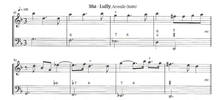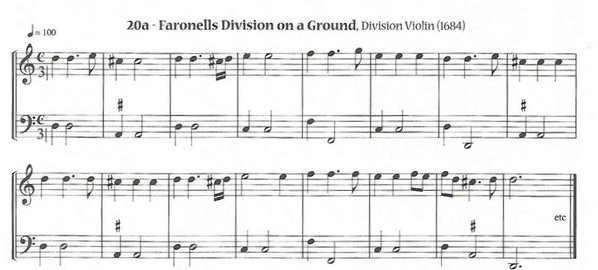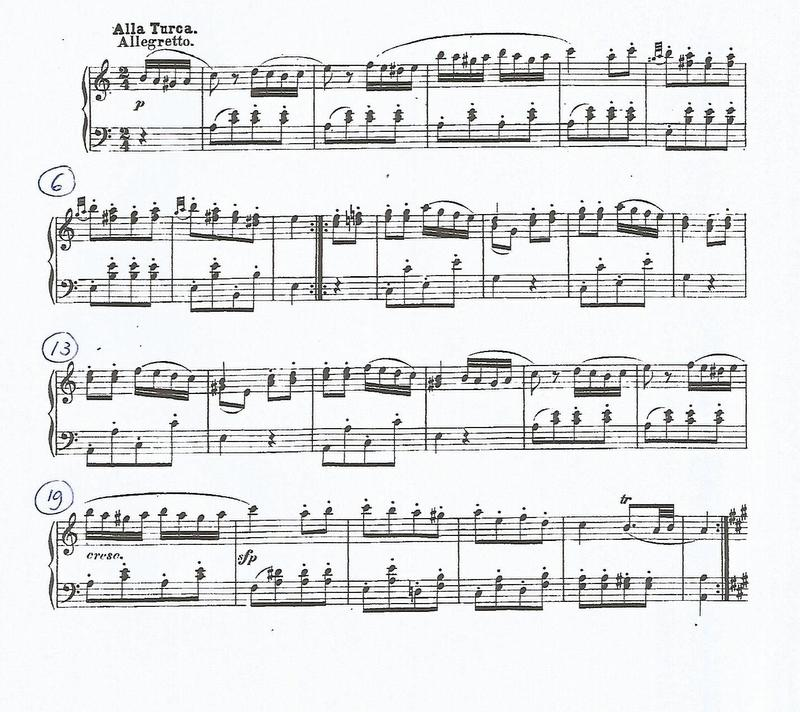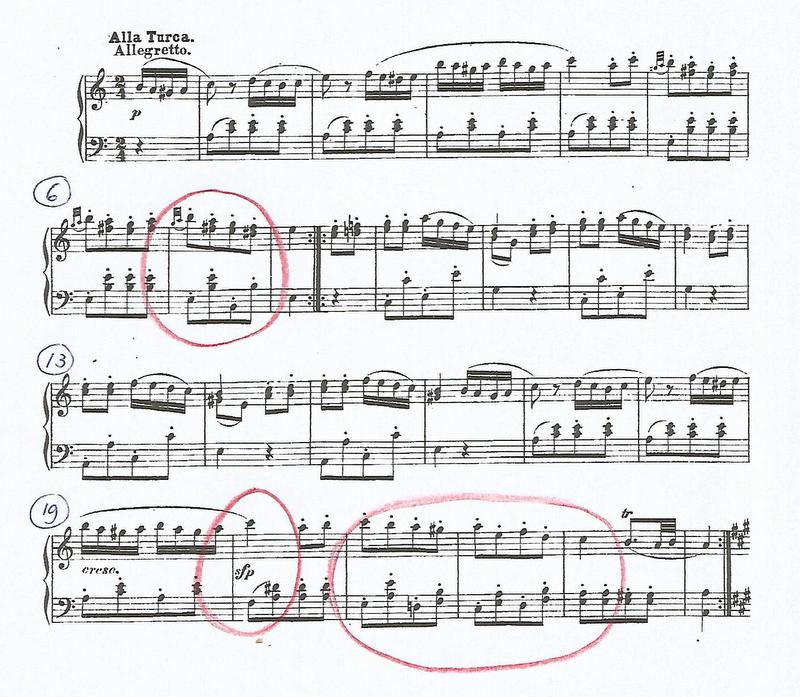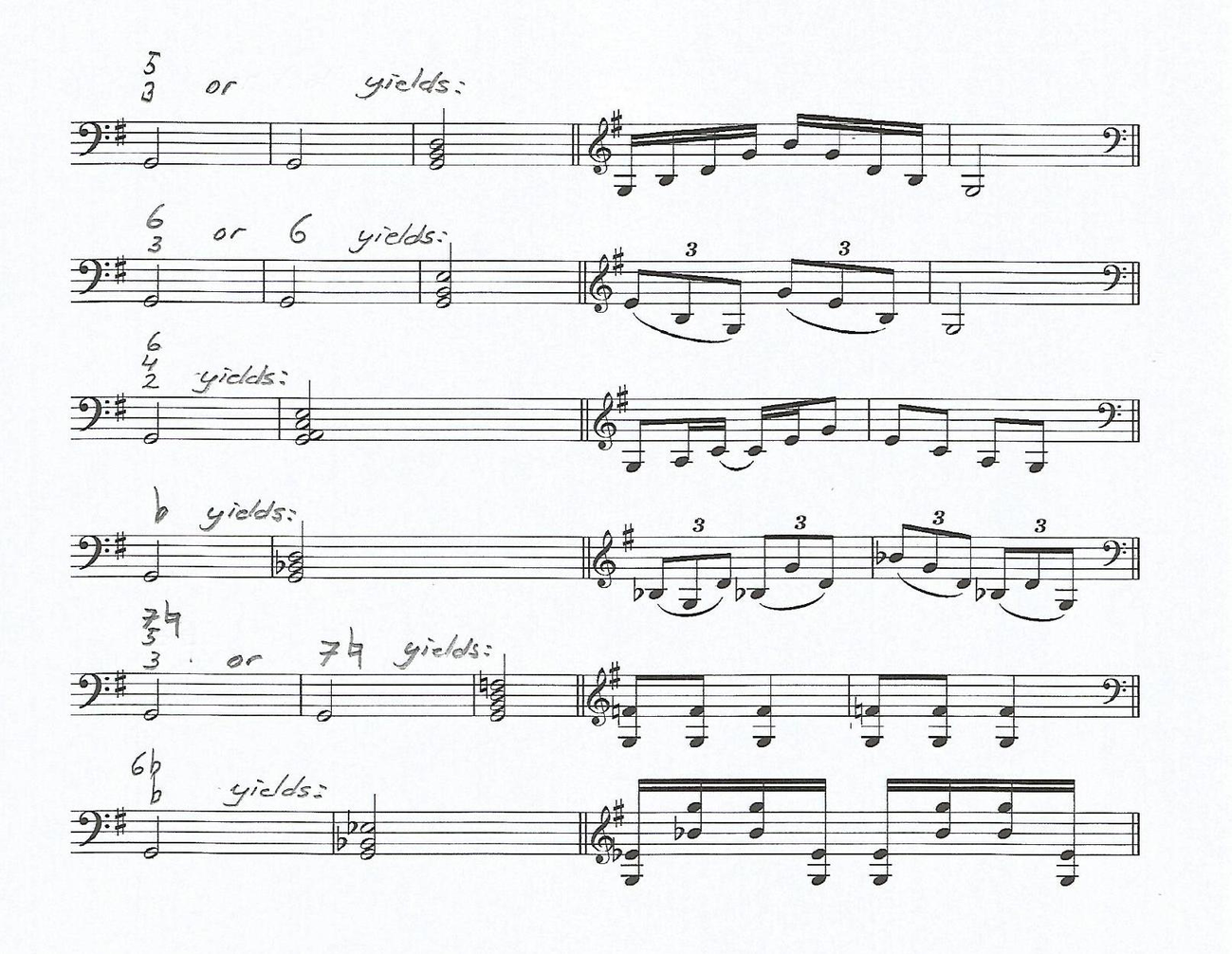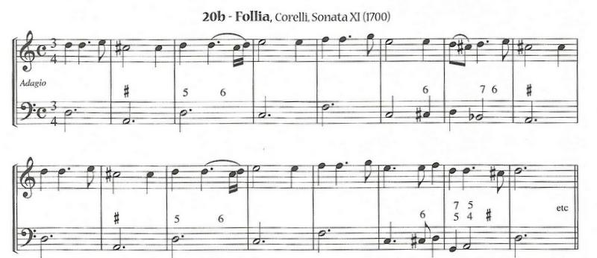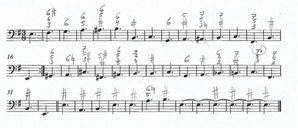Invitations part II - focussing on harmony
1. Ivvi
In Playing ivvi, we:
-
Dive into the chordal fields of a tonic and dominant1, experiencing the movement that happens going from the one to the other, the sensations of tension and release, experiencing these ‘from the inside’.
-
Teach ourselves ways to play out chords on a melodic instrument/the violin
-
Increase awareness of voice-leading
-
Strengthen awareness of the role of different chord tones and of non chord tones
-
Develop our intuitive perception of harmonic colour
-
Enhance the skill of polyphonic hearing
-
Create an attitude of active listening to harmony
|
Decide on a key and a metre. In pairs make the I-V-V-I sequence ‘present’ in a basic way, both players freely playing out the chords. Feel the quality and characteristic of the movement in this chord progression. When doing so, ‘drink in’ the different ‘feel’ of the two different chords. Then decide that one player will ‘safeguard’ the ivvi and the other player will experiment with another voice, melody, material, tones over it. |
After playing ivvis it is important to take time to reflect: How did the different voices move in relation to each other? Were there specific moments that we enjoyed? Did we use mainly chord notes or did we also use other notes? How did we feel about the ‘inner-game’ – did we ‘think about which notes to play’, did we call their names? How did we feel about the different colour or sensation of the I and the V? Did we ‘just play by ear’? What variety in register did we use? In our phrases, what were the ending notes of the phrase and what does that tell us about the closed or ‘less-closed’ character of that phrase-ending?
When the ivvis are ‘warmed up’ by playing them out, there can be a moment to unfold the ‘theory’ (‘pull the theory into what we do’). Compare the two chords shortly in words or note-names (if the level of the participants needs this). Reflect on the seventh of the dominant 7th chord.
The following variation works on voice-leading
|
Variation 1: starting on tonic, third or fifth: Play I-V-V-I - I-V-V-I (two ivvi’s tied together). In pairs, one player ‘safeguards’ the ivvi, the other player plays a melody to it that starts and ends on the third of the tonic. Then play a ‘melody’ that starts and ends on the fifth. Then one that starts and ends on the tonic. |
Reflect on the intervals between melody and bass line that were experienced and of the voices that were created.
Reflect on the movement in this small progression - raise awareness that ivvi is not a sequence of 'four separate events', but a sequence of two connected events: I going to V and V going to I.
Reflect on how ‘flat’ a melody can be and explore ways to embellish flat melodies gradually more and more.
Raise awareness for the common note between the two chords and how building a melody around a common note can happen. It might seem obvious to spend time on just a tonic and a dominant, yet playing with them in ever different ways, will strenghten the 'acquaintance' with them in another way than 'just knowing'. It is vital to respect very elementary steps as they provide the soil for further growth!
|
Variations on Ivvi:
|
When playing out chords ‘on instinct’ like this, try to feel how it is inside the chord – ‘drink it in’.
2. Simple schemes2
When we play Simple schemes, we:
-
Learn how to improvise in a tonal way over harmonic progressions
-
Develop understanding and experience-based knowledge of harmonic movement and of harmonic tension/release
-
Deepen our sensitivity for the relationship between melody and harmony
-
Discover what are violin-specific ways to improvise tonally and what this tells us about violin technique and fingerings
-
Train our musical memory by ear
|
Choose a harmonic progression that is of a good length to be memorized comfortably. Make the progression ‘present’ by playing it out in a fairly basic way, if needed preceded by listening to it. In pairs, first ‘express’ the progression together by both playing freely with or on it. Then take turns, player 1 – who ‘safeguards’ the progression and player 2 – who improvises over it. |
Playing ‘simple schemes’ is a continuation of playing ivvi’s.
A few examples of simple schemes that can be used:
-
Descending bass or Passacaglia
-
La Folia3
-
Monte
-
Romanesca
-
Scheme of Greensleaves
On Simple schemes like these, you can use the ‘voice-leading exercise’ mentioned above. Choose for the beginning note of your improvisation either root, third or fifth of the first chord and start with playing very linear/’flat’. Explore how the voices want to move and what the relationship is between melody and bass.
Violinists tend to do two things when ‘trying to find out what happens in a scheme’: search for the notes of a chord in an arpeggiated way, and/or do the searching pizzicato.
|
Variation 1: theme and variations In pairs, with a chosen simple scheme that is internalised well, create a piece called ‘theme and variations’. Do not decide beforehand how many variations there will be or what their different characters will be. Both players are ‘leading’ and together they try to create a distinct character for every variation, using differences in roles, register, rhythm, colour, dynamic. |
|
Variation 2: theme and variations - with a prelude: The same as above, but one of the players will introduce the theme by a prelude – a short improvisation that uses some of the material of the theme in an introductory way. |
An assignment can be to bring own ‘simple schemes’, that can be distillated from almost every piece of repertoire, not necessarily ‘big’ repertoire – also a ‘Bond tune’, a children’s song, a Christmas carol, a pop-song or the first phrase of repertoire that is being studied. It is good when students bring their own ‘simple schemes’, because they will bring music that they love and the inner connection with music you love is the strongest – working with it therefore the most beneficial/efficient.
3. Modulation game4
In playing the Modulation game, we
-
Strengthen our understanding of ‘key notes’ (or 'signal notes') in modulating and become more fluent in using them
-
Develop our ability to make harmonic analyses of repertoire while playing (that is: without stopping)
-
Develop our notion of movements of harmonic progressions
-
Exercise becoming skillful in creating modulations in tonal improvisation
-
Build consciousness of diatonic and non-diatonic tones in scales
-
Enhance our sensitivity for and active listening to modulations
-
Set a first step towards becoming a ‘co-composer’
|
Choose a key and start with playing Q&A in this key. Then choose a key that you are planning to modulate to. Start with easier/logical choices first, for example moving to the dominant or to the relative major or minor key. Player 1 presents a phrase/question in the chosen tonality, player 2 plays an answer in which he modulates to the second chosen key. |
Before playing, one has to realize which note is the ‘key note’ for the new tonality: it will be the leading tone to this new tonality and this note ‘wants’ to be followed by the ‘new tonic’ to convince that we really modulated - if this note sounds, but is not leading to or followed by the new tonic, it can also be perceived as a passing note, or a chromatic ornamentation. It is very natural to start the answer with a repeat of the first part of the question, or to use/imitate thematic material from the question as the beginning of the answer.
For example: starting in D major and modulating to A major, the note that will ‘do the job’ is the g-sharp leading to A. The note G is the note that is different in the tone material of the original key, D major (two sharps, so no G-sharps) and the tone material of the new key, A major (three sharps, so G-sharp). The G is the seventh of the dominant seventh chord (A7) in D major, it is the fourth note of the original scale D and it is the third of the dominant seventh chord (E7) of the new key, A major).
A good example of ‘keynote and the confirmation of the new key’ is the famous Minuetto by Boccherini. ‘Only moving to the new key’ is not always perceived as ‘convincing’ to feel that we ‘really are at home’ in that new key. A confirmation of the new key might be needed. This Minuetto gives a clear example of that. A confirmation can be created for example by a strong cadence – I-IV-V-I in the new key.
To elaborate, to take it to a higher level, modulate to keys that are further away from the original key in the cycle of fifths – and thus have less common notes. If this proves difficult to do, start with not aiming for a specific key first, but just ‘trying out random versions', giving answers that are ‘just using’ non-diatonic (meaning: notes that are not in the note material of the original key) notes in a melodic way ‘that you like’ and afterwards ‘see where that has lead to’.
|
Variation 1 – a piece of repertoire as a start Choose a (first half of a) phrase from the classical repertoire that starts on tonic and finishes on dominant (as many classical phrases do, see below for example). Consider the key that the fragment is in. Then choose a key to modulate to. In pairs, player 1 plays the original phrase, player two answers with the beginning of the original phrase, modulating to the chosen second key. |
The audio on the right presents an example: the theme of the 2nd movement of Eine kleine Nachtmusik, with improvised 'answers' modulating to G major, a minor, d minor, c minor.
Note that the ‘tonally free Q&A’ from invitations - part I, has been ‘preparing ground’ for this game. The two invitations are connected.
4. Sing and play – 2 5
By doing Sing and play – 2, we:
-
Train our polyphonic hearing
-
Grow in listening to bass lines when playing melodies
-
Increase awareness of tension and release in the relationship between bass line and melody
-
Strengthen our musical imagination
To use Sing and Play in a way that it focuses on pitch and harmony, the following, several options can be useful to do. Some of them might be more suitable for ‘in the practice room’ than in a group lesson situation, but with some adaptation or in the right setting they might also be valuable and user-friendly in the latter.
|
Option 1 – over a drone: Choose a note that is comfortable in pitch to sing. Sing the tone in a long-hold drone-note and play something over it. All players can sing the note and in turns every individual player can play something on the drone (while continuing the singing). Also reversed – playing the drone note on the violin and singing small phrases to it. |
|
Option 2 – in unison: Improvise phrases or melodies that you sing and play on the violin in unison. |
Do you play what you sing or do you sing what you play? What is the energy that is steering the music? How can you make variations, shifts in balance between those two? What does it tell you about your violin technique – to what extent is your violin technique in this exercise ‘shadowing’ the impulse coming from your musical intuition, emotion, sense of atmosphere, inner energy?
|
Option 3 – improvise on a scale: Choose a one octave scale. Play the first note of the scale and sing a short motive on it, play the second note and sing a next motive on that, and so on. Also the reversed way, sing the first note of a scale and play something on it. |
For violinists, Sing and play games pose some difficulties: in the first place – we have the ‘violin under our chin’, which is not the most comfortable posture for singing. One could solve that problem by using the violin in ‘guitar position’ and play pizzicato. The drawbacks of this solution are that 1) the sound that comes out of a pizzicato bass note played like this, does not have much resonance and therefore is not very helpful or inviting to sing over and 2) playing like this is not a familiar thing to do for violinists, therefore there are strong ‘technical limits’ (‘clumsiness, a feeling of ‘not-at-ease’) and therefore one does not naturally feel the ‘musician’ one normally is. Also, the register of the violin does pose some disadvantages to singing over it, compared with for example the cello. The lower register of the cello gives a strong resonating cloud of overtones on which ‘ground’ the voice can ‘join in’ more easily - the overtones producing ‘acoustic’, hence the voice not feeling so ‘lonely’ or dry. In singing and playing with the violin, our voice register (for female students and children roughly from central C to E’) largely overlaps with the violin pitch, making the total register quite narrow and not so warm. Despite those disadvantages for violinists, it is definitely something that should not be skipped, to Sing and play.
There is a lot more to be investigated further in how voice and sound of the violin ‘mix’ when performed by the same person.
|
Option 4 – on an improvised bass line: Play a sequence of at least two bass notes and sing motives to it. Then play a next short sequence and sing to it. And so on. Also reversed: singing the bass notes and playing the motives. Also in pairs, player 1 providing bass notes on the violin, player 2 singing to it and vice versa. |
This exercise is developing the skill of experiencing polyphonic lines, following the movements of both lines, listening less vertically, more horizontally. Aim at keeping a sense of flow, direction, movement in the music, when doing this.
Taking it to a further level would involve trying out three voice sing and play improvisations - double stop parts on the violin, and voice. Not an easy thing to do.
|
Option 5 – on a piece of repertoire: Choose a simple scheme or a piece of (classical) repertoire that you love. Figure out a bass line and sing that bass line a few times. Then play the bass line and sing the melody. Also reversed: sing the bass line and play the melody. Then play the same bass line, singing something else on top. Also reversed: sing the same bass line and play something else on top. |
This is a challenging thing to do as well. A step in between can be helpful: not singing and playing the bass line and melody at exactly the same time, but initially the bass note a fraction before the melody (‘kedeng, kedeng’). By the sheer fact of doing this, internalized harmonic awareness (with a physical component!) is developed strongly.
|
Option 6 – Sing and play canons: Choose a well-known canon and Sing and play it (voice and violin). |
When working for example on César Franck's Violin Sonata, this is a great thing to do with the fourth movement. Although difficult, the doing of it adds positively in the active listening and ensemble playing when performing the piece.
5. Unwrapping repertoire
In Unwrapping repertoire, we
-
Learn to make harmonic reductions by playing
-
Become skillful in ‘playing around creatively’ with the harmonic skeleton of a piece of repertoire
-
In doing so, discover from the inside, the importance and ‘taste’ of significant moments, ‘happenings’ in this repertoire
-
Enhance our understanding of what makes the musical language of a composer so typical for this composer (what makes Schubert so typically Schubert?)
-
Discover stylistic effects (that can be humorous, convincing, distinct)
|
Choose a piece of well-known repertoire. Make the ‘tune’ present by playing it in unison or by singing it. In pairs, player 1 plays provides the tune and player 2 improvises ‘something that could go with it’. You can think of ‘a bass line’, but also just notes that fit well with it can be a good start, from which one can grow towards a fuller ‘second line’. |
Making the tune present by playing it out by ear on the violin is already a good exercise in itself (for some people not that easy). To strengthen skills here, transpose the tune through the different keys. Transposing does not mean: moving every note one tone up (for example), but it means having the relationship between the notes internalized. Games can be added to this phase: playing the tune ‘socially’, meaning for example that player 1 plays the first four bars, player two plays the second four bars and so on. Try to not only be ‘correct’ in the sense of right notes and rhythms, but also to listen and adjust to colors, dynamics, style of playing of your co-players.
Suggestions when experiencing difficulties in ‘finding what is underneath’:
-
Look for the places where the ‘underneath voice’ ís changing, without wondering yet how it is changing
-
Clap or imagine a ‘drum part’ to the tune. An instinctively created rhythmic accompaniment frequently turns out to be depicting the harmonic rhythm.
-
Do not stop at moments where you are still ‘in the dark’, but leave those spots ‘empty’ and keep playing, continue when you feel ‘ground under the feet’ again
-
Explore and also enjoy (!) ‘wrong notes'. By experiencing what ‘does not feel good’, you grow towards what ‘does feel good’
-
Do not move until you feel you have to move. Initially, sustain bass notes as long as possible
|
Variation 1 – 'variations on….': with the skeleton of a chosen piece of repertoire in mind, in pairs, improvise something else on the skeleton. (For example: playing a Waltz on the skeleton of Mozart’s – Alla Turca, playing a ‘minimalistic version’ of Schubert’s – Die Forelle, playing a ‘stumbling version’ of Brahms’ – Lullaby) |
Below an example of ‘unwrapping repertoire’ and what it can bring to do so – the first 24 bars of Mozart’s Rondo Alla Turca - third movement of Sonata nr. 11, KV 331:
The questions that are arising while playing it out, are: what is happening in bar 7, what is the chord in bar 20, what is happening in bars 21-23?
Interestingly (but not surprisingly), those questions exactly reflect the ‘exciting’ moments in the fragment. In bars 7 and 21-23 it is the doubling of the harmonic rhythm that is experienced. In bar 7 it is the ‘mini-modulating’ to E ( is it e-minor or E-major!?) that is felt (note: the ‘key note’ from the modulation game being the D-sharp leading to E, the chord on the second half of the bar being the ‘V to the V of the original key’).
The chord of bar 20 is ‘a fascinating one’, when brought ‘above the surface’ and looked upon, it turns out to be a german sixth chord, leading to a I 6/4.
this moment being the ‘moment of shock’ in these 24 bars - by playing out in this way and searching for oneself, that ‘fact’ will not be ‘taken for granted’ anymore, when performing the piece. The doubling of the harmonic rhythm after this eventful happening is making a lot of sense - ‘after this dramatic experience, run to your home! Bars 21 and 22 do not offer a ‘normal’ I 6/4 - V I 6/4 - V progression, but instead: I 6/4 – VII 4/3 I 6 – II 6.
A question that could come up: where in the 24 bars would ‘a little cadenza’ feel appropriate? This question undoubtedly can be answered easily after having explored the fragment like this. In following improvisations on the skeleton, a little cadenza might be played. A next time the piece is performed in the original version, sensitivity to ‘that cadenza moment’ will be internalised, possibly resulting in a different timing, color or dynamic in the performance.
It is obvious how a ‘structure analysis’ of the first 24 bars of the piece is ‘internalised’ in an ‘active way’ after playing in the above mentioned way. Unwrapping repertoire hence leads to more profound understanding of the repertoire that one performs.
|
Less tonal variations on ‘unwrapping repertoire’ (if one feels for ‘something different’ during a session)
|
When coming back to ‘variation 1’- playing tonal variations on the harmonic skeleton - these more ‘out of the box’ variations, might help to stay more free while improvising tonally.
6. Violin and the figured bass6
When working with Violin and the figured bass, we:
- Gain insight in this old, traditional and functional way of ‘writing music down without fixing it too much’
- Become skillful in a tool that can help us enter the repertoire we perform in a more complete way
- Learn how to play out figured bass lines on the violin
- Learn a tool that can help us making harmonic reductions of repertoire we perform
- Are offered a concentrated visual aid, to start improvisations on
|
Listen to a piece of classical repertoire of your choice. Focus your attention towards following the bass line. Try to sing along the bass line. The next time, play along the bass line on your violin. Play the bass line without the piece of repertoire being played. Write down the bass line you just played. By ear play out the chords over the bass line. Write down the numbers above the bass notes. Improvise possible expressions on the violin of this figured bass line. |
Figured bass is a notation system that does not write down ‘too much’ (in order to leave space for creative improvisation), but does not write down ‘too little’ either (it can depict both the chord and the inversion/bass note). Although at first the numbers might look daunting, the system turns out to be far less complicated than one might think.
In short, basic guidelines for figured bass are7
- The written bass note represents the bass note in the bass line
- Without any mention above this bass note, the chord at that moment is the diatonic8 triad on that bass note.
- A 6 above a bass note means that instead of the fifth, the sixth above that bass note creates the chord. This in togetherness with the third, that might not be written, but is supposed to sound as well. (A 6 above the note therefore means that the chord at that moment is a first inversion of the triad on the note that is a third below the notated bass note)
- The 3 for a third above the bass note is very often not written, but still it will sound.
- In the same way other numbers above the bass note (for example a 2, 4, 7, or 9) indicate that those intervals above that bass note are creating the chord at that moment. Those intervals always according to the key signature of the piece.
- When an accidental is written next to a number, it means that the note represented by that number is ‘receiving’ that sharp, flat or natural (in some ‘editions’ a sharp next to a number is replaced by a slash through that number – its meaning is the same, the note that is represented by that number will be raised with a half tone).
- When an accidental is written above a bass note without a number before the accidental, it means that this accidental belongs to the third above the bass note (because writing the 3 for the third is omitted)
The following examples clarify those rules. In the second half of each staff a ('randomly chosen') possible way of playing the chord out on the violin is written down.
An interesting and challenging aspect of playing out harmony on the violin shows itself here: we can play out chords and make a 'suggestion' of the bass note, but as we are a melody instrument, we can not present the bass note and inversions as unambiguously as a harmony instrument. The last staff, for example, might have been 'understood' as the playing out of an E-flat major chord in root position, with bass note E-flat. Yet, there is a way to suggest the bass note, by playing the figures in such a manner that 'the ear' naturally will 'recognise' the bass note.
Naturally, there might be one difficulty for violinists embarking on this, that is the reading of the bass clef. It is also possible to write out the bass lines in treble clef.
A more in-depth look on figured bass and the violin is provided in the next chapter and in the Appendix I. Once players are more familiar with playing with figured bass lines, it can be used in group lessons in the following way.
|
Variation 1 – duet on a figured bass line: Choose a written out figured bass line (or provide one yourself). Two players ‘play it out’, improvise on it, either without any ‘agreements’ on how or what to play or with a decision that player 1 provides more of a ‘bass role’ and player 2 will play an ‘upper voice’. Change roles. |
7. A bass line for Bach9
Before the description of this last invitation, a short personal note.
During my three day visit to the Yehudi Menuhin School in 2016, I have listened to many hours of ‘bass lines for Bach’ – work that David Dolan did with the pupils on movements of the Sonatas and Partitas for Violin Solo by Johann Sebastian Bach and movements of the Suites for Cello Solo by Johann Sebastian Bach. Those moments made an everlasting impression. What happened there – the gradual ‘unfolding’ of the deeper layers of this unbelievable music, the mild way in which young people were taken by the hand into the ‘real inside’ of this music – was deeply touching. After this experience, it is my belief that one cannot play, perform, understand or teach those movements thoroughly without doing work like this. For the first time in my life, I started to experience a beginning of ‘understanding’ this music, that I of course had played and taught already many times.
This last invitation can thus be seen as an ‘end-focus’ of the way of working developed in this research. The ‘full size’ of this invitation falls outside the scope of this research (it would be a great research in itself). it has ‘no end’ – it is an ever-growing adventure both in understanding Bach’s music as in diving into deeper layers of harmonic awareness.
In playing ‘A bass line for Bach’, we:
- Make a start with understanding the Solo Sonatas and Partitas by Johann Sebastian Bach on a deeper level
- Use our improvisational skills so far in connection with this music
- Increase awareness about how ‘modern’, creative, exciting Bach’s use of harmony is. (‘after Bach there has not been anything new harmonically’)
|
Decide on a movement of Bach Solo Violin Sonatas or Partitas that is known to all participants. In pairs, player 1 plays the full text, player 2 improvises an ‘other voice’/bass line to it. Change roles. |
Some comments regarding this invitation:
- When doing this, be aware of the fact that in baroque music the bass line is the leading voice. The player that performs this bass line therefore tries to do this in a ‘leading way’.
- When initially one is ‘lost’ for a while, don’t stop playing! The thinking mind will start to try to take over, but this thinking mind is far too slow to ‘capture’ the essence of the music. Play within the flow and movement of the music, so that you can stay closer to intuitive music-making.
- It will be obvious that there is not ‘one right version’ of a bass line.
- When it comes to voice leading, in general the most ‘linear’ is the most natural.
- It is fascinating to explore how Bach 'solved' the aspect of a 'hidden, but recognisable bass line' - the aspect mentioned above regarding the examples of figured bass - how in these movements bass line and melodic material are interwoven in one part, and yet the music being polyphonic.
· After having played through a movement in this way, take time to discuss what was striking. What new experiences or insights in the music did this playing together bring? What does it tell you about the structure and about tension and release of the movement?
T
To take it to a next level, the following variation can be useful.
|
Variation 1: on the harmonic structure of a movement of Bach Solo repertoire that has been ‘unfolded’, improvise freely together – not playing ‘Bach’ anymore, but leaving the harmonic structure intact, leading to different narratives of the same piece. |
It is interesting to know that in the past composers have been seduced to provide bass lines to the Solo Sonatas and Partitas already. Robert Schumann composed piano accompaniments to them. Mendelssohn composed an accompaniment to the Ciaconna from Partita nr. 2 in d-minor
